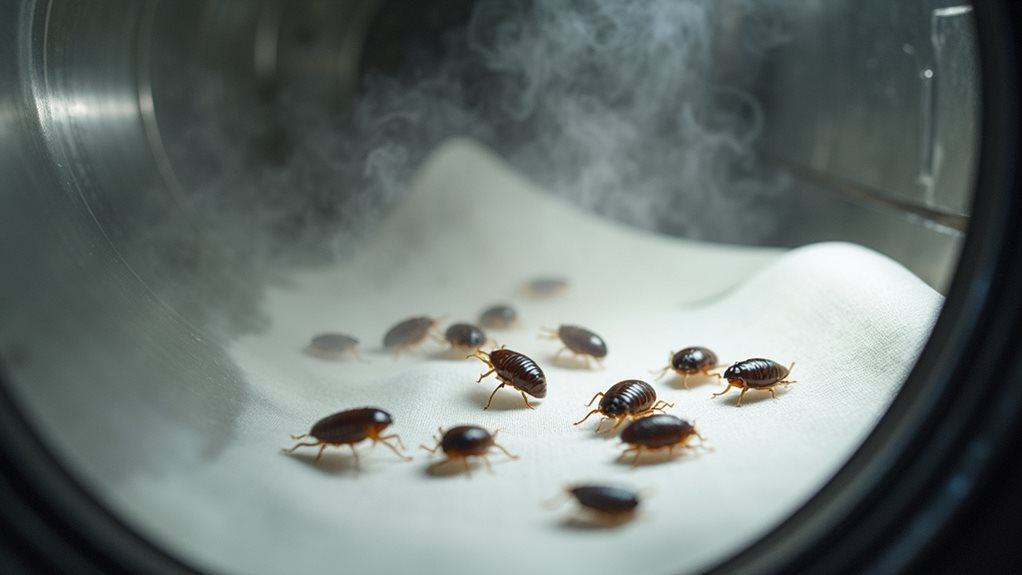While dry cleaning can kill adult bed bugs through its chemical solvents like perchloroethylene and high heat, it’s honestly not your complete solution to these persistent pests. The process effectively eliminates grown bugs on contact, but those sneaky eggs often survive in fabric seams and crevices where the chemicals can’t reach. You’ll need dry cleaning as part of a broader strategy, since reinfestation happens when eggs hatch and discover you’ve only won half the battle.
Understanding Bed Bugs and Their Behavior
Before you can tackle a bed bug problem effectively, you’ll need to understand what you’re actually dealing with, because these tiny vampires are far more cunning than most people realize.
These reddish-brown insects are masters of disguise, creating hiding spots in mattress seams, furniture cracks, and even picture frames during daylight hours. They feed on human blood while you sleep, leaving behind those telltale red itchy welts that appear in clusters or lines across your skin.
What makes bed bugs particularly troublesome is how they reproduce quickly—a single female can lay up to 500 eggs, turning a minor issue into major infestations rapidly.
They survive in various environments, which is why thorough eradication strategies involving extreme temperatures often become the most effective control method. For complete elimination, bed bug treatment should be combined with other integrated pest management strategies rather than relying on a single approach.
How the Dry Cleaning Process Works
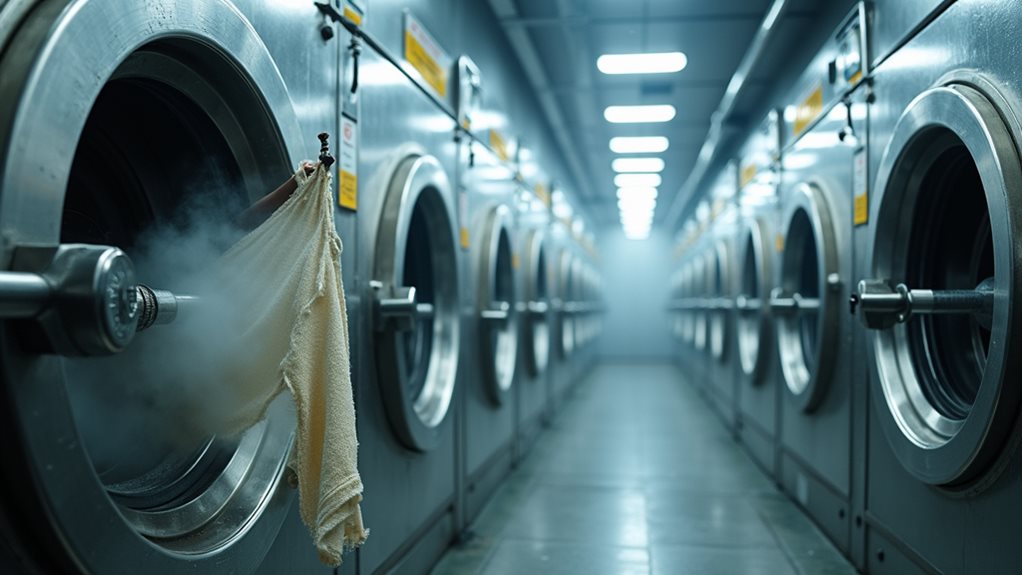
The dry cleaning process might seem like magic when you drop off your favorite blazer stained with mystery sauce and pick it up looking pristine, but understanding how it actually works can help you determine whether it’s your secret weapon against bed bugs.
Instead of water, this clever system uses chemical solvents, primarily perchloroethylene (PERC), to clean fabrics and tackle stain removal. Your infested clothing gets inspected first, then tumbled in machines that circulate these powerful solvents at high temperatures, creating conditions that can kill bed bugs on contact.
However, here’s the catch – while PERC effectively eliminates adult bugs, those sneaky bed bug eggs hiding in seams might survive the process, which is why visual inspection afterward remains essential for complete peace of mind. The heat from dry cleaning machines typically reaches temperatures that exceed the thermal death point for bed bugs and their eggs, making it an effective treatment method for fabric items.
Effectiveness of Dry Cleaning Against Bed Bugs
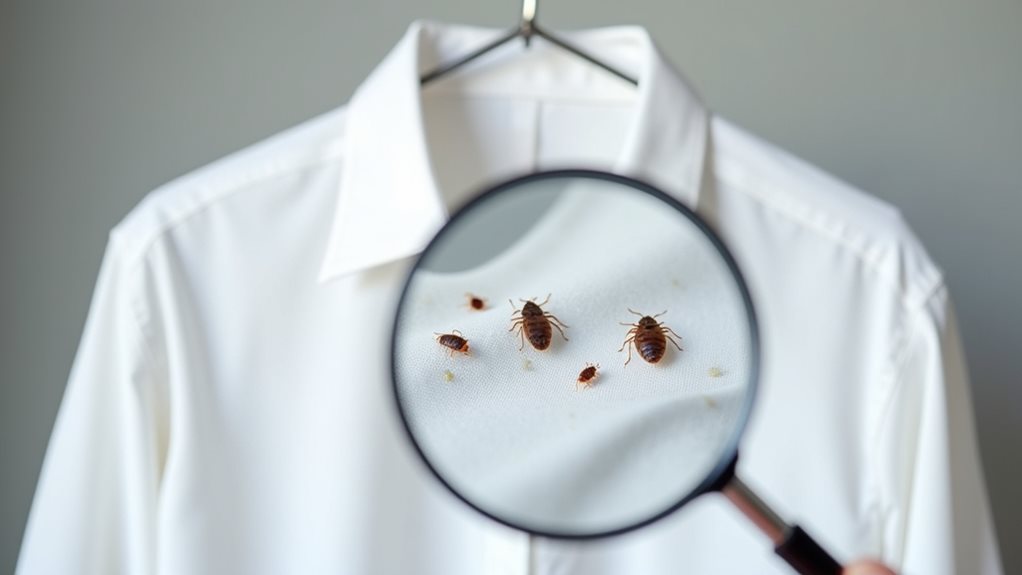
You’ve probably wondered if those harsh chemical solvents used in dry cleaning can actually knockout bed bugs, and honestly, they’re pretty effective at killing adult bugs on contact – kind of like a chemical warfare situation that works in your favor.
However, here’s where things get tricky: while PERC and other solvents can eliminate the bugs they directly touch, those sneaky little eggs tucked deep into fabric seams often survive the process, which means you might think you’ve won the battle only to face round two in a few weeks 😅.
The heat component of standard dry cleaning also falls short of the sustained 113°F temperatures needed for guaranteed elimination, so you’re getting partial protection rather than the complete victory you’re hoping for.
For complete elimination of an infestation, you’ll need a more comprehensive integrated pest management approach that addresses bed bugs hiding in mattresses, furniture, and other areas beyond just your clothing and bedding.
Chemical Solvent Effectiveness
When I first discovered bed bugs in my apartment, I’ll admit I desperately threw every piece of fabric I owned into bags and rushed to the dry cleaner, hoping their chemical arsenal would solve my nightmare 😅.
The good news is that perchloroethylene, the primary solvent used in dry cleaning, can indeed kill adult bed bugs effectively. This powerful chemical packs enough punch to eliminate the grown-up critters lurking in your clothing, which honestly gave me some hope during those dark, itchy days.
However, here’s where things get tricky – while the solvent works well against adults, it doesn’t consistently reach the high temperatures needed to destroy bed bug eggs, meaning your infestation could potentially bounce back even after thorough cleaning.
The heat exposure during the dry cleaning process is actually what makes this method lethal to bed bugs, as commercial dry cleaning machines typically reach temperatures that can kill both bugs and their eggs when sustained for adequate duration.
Heat Treatment Limitations
Beyond the chemical warfare happening in those industrial machines, I quickly learned that dry cleaning‘s heat component – or rather, the lack of sufficient heat – becomes a real problem when you’re dealing with those stubborn bed bug eggs.
While chemical solvents might effectively eliminate adult bed bugs, the dry cleaning process typically doesn’t reach those vital temperatures of at least 120°F needed to destroy eggs completely.
This heat treatment limitation means you’re fundamentally playing whack-a-mole with infestations – sure, you’ll knock out the visible crawlers, but those protected eggs will hatch later, restarting your nightmare cycle.
Additionally, prolonged exposure to traditional dry cleaning chemicals like perchloroethylene can create respiratory irritation and other health concerns, making this approach less than ideal for repeated treatments.
That’s when I realized professional pest control becomes absolutely necessary, because dry cleaning alone simply can’t deliver the thorough heat treatment required for total bed bug elimination.
Limitations of Dry Cleaning for Bed Bug Control
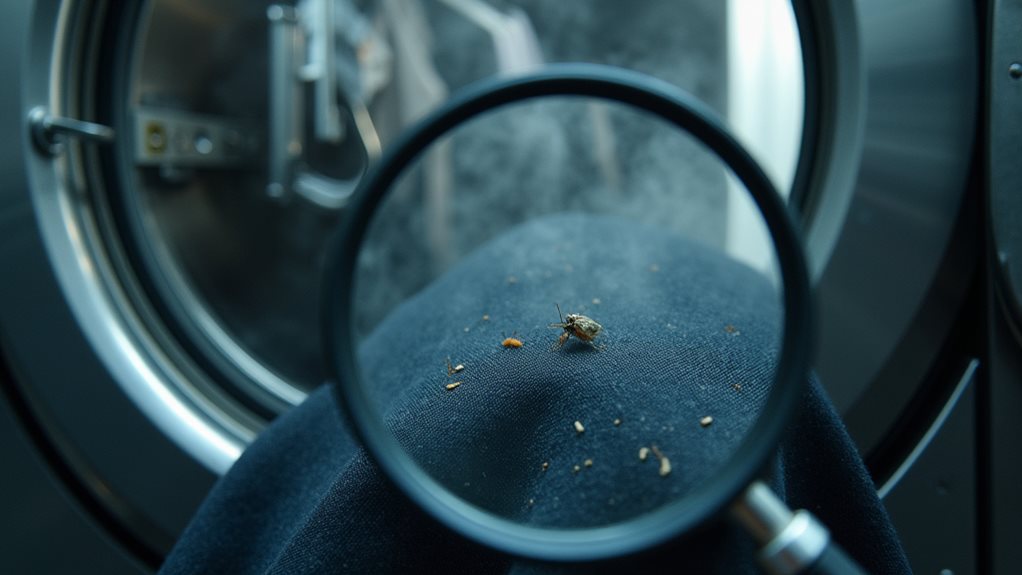
Although dry cleaning might seem like a silver bullet for eliminating bed bugs from your clothing and fabrics, I’ve learned through years of helping homeowners tackle these persistent pests that this method comes with some pretty considerable limitations you need to understand.
While the chemical solvents used in dry cleaning can kill adult bed bugs on contact, they often miss eggs tucked away in seams and fabric cracks, creating a frustrating cycle of reinfestation weeks later.
The process rarely reaches the sustained high temperatures necessary for complete elimination, and frankly, it only addresses items you can actually dry clean—not your mattress, furniture, or the broader environment where these critters love to hide.
For effective control of serious infestations, you’ll need professional pest control methods.
Alternative Methods for Eliminating Bed Bugs
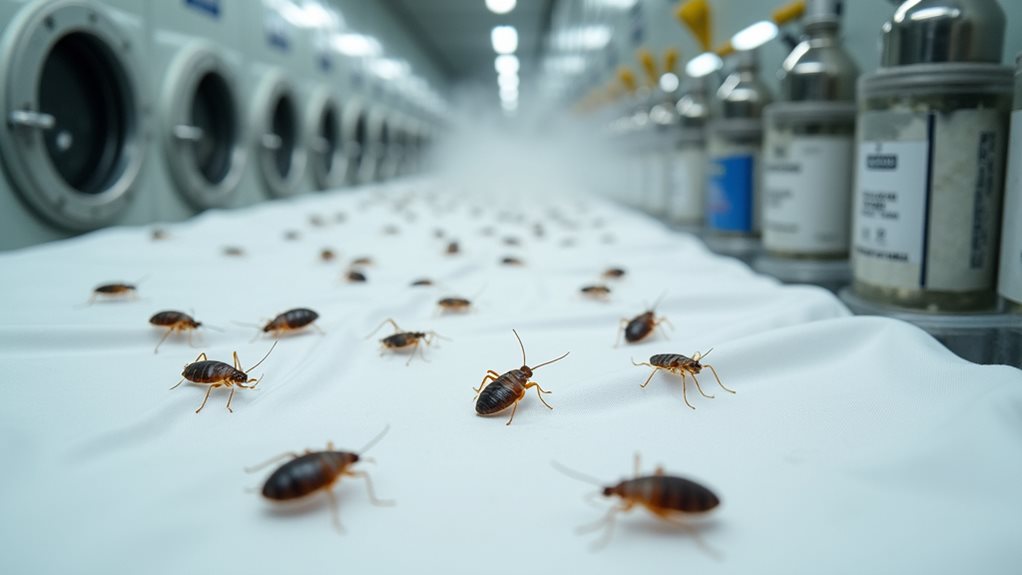
If dry cleaning isn’t cutting it for your bed bug battle, don’t worry—you’ve got several powerful weapons in your arsenal that can actually win this war.
Heat treatment stands as your nuclear option, where professional exterminators basically turn your home into a giant oven, cranking temperatures above 113°F to cook those critters and their eggs into oblivion (I’ve seen grown adults get genuinely excited watching bed bugs meet their heated demise 🔥).
On the flip side, you can freeze smaller items by tossing them into your freezer at 0°F for several days, though I’ll warn you that explaining frozen pillows to houseguests requires some creative storytelling skills.
Just like with mold contamination, you’ll need to address the underlying problem that allowed bed bugs to establish themselves in the first place, which often means sealing cracks, reducing clutter, and maintaining vigilant monitoring even after treatment.
Heat Treatment Methods
When dealing with stubborn bed bug infestations, heat treatment emerges as one of the most reliable weapons in your arsenal, offering a chemical-free approach that literally cooks these unwelcome guests out of existence.
These heat treatment methods work by raising infested items to temperatures of at least 113°F, though you’ll want to hit 120°F for thirty minutes to truly eliminate bed bugs at every life stage.
Professional pest control services use specialized equipment that delivers high heat uniformly throughout your space, penetrating deep into fabric crevices where these critters love to hide.
What I love most about this approach is that it’s completely environmentally friendly and non-toxic – no harsh chemicals required!
For maximum effectiveness, combine heat treatment with integrated pest management strategies.
Cold Treatment Options
While heat might be the popular kid in the bed bug elimination class, cold treatment deserves just as much respect for its quiet, methodical approach to freezing these pests into oblivion.
Unlike dry cleaning’s high heat methods, freezing offers an effective method for eliminating bed bugs from non-washable items that can’t handle intense temperatures.
You’ll need to seal infested items in airtight bags, then expose them to 0°F for at least four days – think of it as putting those pesky critters in timeout, permanently 😊.
This chemical-free approach works beautifully for delicate fabrics and plush toys, though I’ll admit it requires patience since cold treatment can take longer than other methods for severe infestations.
Insecticide Application Techniques
Beyond the patient world of freezing temperatures, insecticide applications offer a more aggressive, chemical-based approach that can tackle bed bug infestations with targeted precision.
You’ll find these cleaning chemicals come in sprays, powders, and liquids, each designed to disrupt the nervous systems of these persistent pests.
While dry cleaning solvents might eliminate bed bugs in fabrics, your broader bed bug problem requires strategic thinking—choose products specifically labeled for bed bug treatment, follow instructions religiously, and prepare for multiple applications since these critters are surprisingly resilient.
However, be aware that traditional dry cleaning chemicals like perchloroethylene (PERC) have been classified as probable human carcinogens, so proper ventilation and safety precautions are essential when using any chemical treatments.
A professional pest control company often combines insecticide applications with integrated pest management strategies, including professional heat treatments and thorough vacuuming, creating an all-encompassing attack that’s effective in killing bed bugs across all life stages.
Best Practices for Preventing Bed Bug Infestations
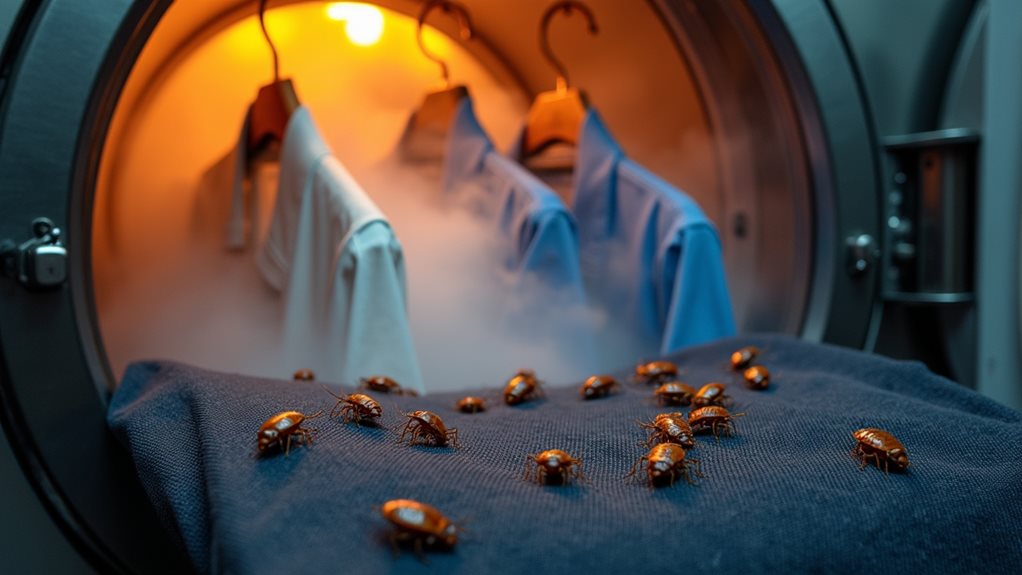
After dealing with a bed bug nightmare in my college dorm (trust me, you don’t want to experience that particular horror show), I’ve become somewhat obsessed with prevention strategies that actually work.
Regular inspections of mattress seams, bed frames, and carpets can prevent bed bugs from establishing their tiny empire in your space. Protective encasements create barriers that make future inspections easier while keeping those unwanted guests out.
Stay vigilant with regular mattress and carpet checks – these simple inspections are your first line of defense against unwelcome tiny invaders.
When traveling, inspect hotel beds thoroughly and keep your luggage raised – I learned this lesson the hard way 😅.
Wash clean laundry and infested clothes at high temperatures, or consider dry cleaning for delicate items. However, be sure to air out dry cleaned garments before bringing them into your bedroom since PERC residues from traditional dry cleaning solvents can remain on freshly cleaned clothes.
Sealing cracks and crevices eliminates hiding spots, turning your home into a fortress against bed bug infestation.

